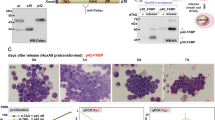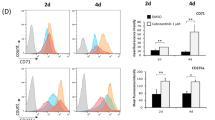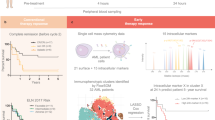Abstract
The chronic myelogenous leukemic K562 cell line carrying Bcr-Abl tyrosine kinase is considered as pluripotent hematopoietic progenitor cells expressing markers for erythroid, granulocytic, monocytic, and megakaryocytic lineages. Here we investigated the signaling modulations required for induction of erythroid differentiation of K562 cells. When the K562 cells were treated with herbimycin A (an inhibitor of protein tyrosine kinase), ras antisense oligonucleotide, and PD98059 (a specific inhibitor of MEK), inhibition of ERK/MAPK activity and cell growth, and induction of erythroid differentiation were observed. The ras mutant, pZIPRas61leu-transfected cells, K562-Ras61leu, have shown a markedly decreased cell proliferation rate with approximately 2-fold doubling time, compared with the parental K562 cells, and about 60% of these cells have shown the phenotype of erythroid differentiation. In addition, herbimycin A inhibited the growth rate and increased the erythroid differentiation, but did not affect the elevated activity of ERK/MAPK in the K562-Ras61leu cells. On the other hand, effects of PD98059 on the growth and differentiation of K562-Ras61leu cells were biphasic. At low concentration of PD98059, which inhibited the elevated activity of ERK/MAPK to the level of parental cells, the growth rate increased and the erythroid differentiation decreased slightly, and at high concentration of PD98059, which inhibited the elevated activity of ERK/MAPK below that of the parental cells, the growth rate turned down and the erythroid differentiation was restored to the untreated control level. Taken together, these results suggest that an appropriate activity of ERK/MAPK is required to maintain the rapid growth and transformed phenotype of K562 cells.
Similar content being viewed by others
Article PDF
Author information
Authors and Affiliations
Rights and permissions
This is an Open Access article distributed under the terms of the Creative Commons Attribution Non-Commercial License (http://creativecommons.org/licenses/by-nc/3.0/) which permits unrestricted non-commercial use, distribution, and reproduction in any medium, provided the original work is properly cited.
About this article
Cite this article
Kang, CD., Do, IR., Kim, KW. et al. Role of Ras/ERK-dependent pathway in the erythroid differentiation of K562 cells. Exp Mol Med 31, 76–82 (1999). https://doi.org/10.1038/emm.1999.13
Published:
Issue date:
DOI: https://doi.org/10.1038/emm.1999.13
Keywords
This article is cited by
-
Phosphorylation of SOS1 on tyrosine 1196 promotes its RAC GEF activity and contributes to BCR-ABL leukemogenesis
Leukemia (2018)
-
Notch1-promoted TRPA1 expression in erythroleukemic cells suppresses erythroid but enhances megakaryocyte differentiation
Scientific Reports (2017)
-
The role of myostatin in muscle wasting: an overview
Journal of Cachexia, Sarcopenia and Muscle (2011)
-
Additive effects of PI3-kinase and MAPK activities on NB4 cell granulocyte differentiation: potential role of phosphatidylinositol 3-kinase γ
Journal of Cancer Research and Clinical Oncology (2008)
-
RIZ1 repression is associated with insulin-like growth factor-1 signaling activation in chronic myeloid leukemia cell lines
Oncogene (2007)



